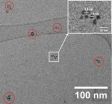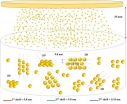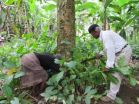(Press-News.org) This news release is available in German.
This was determined using Small-Angle X-ray Scattering (SAXS) at BESSY II. A thorough examination with an electron microscope (TEM) confirmed their result. "The research on this phenomenon is now proceeding because we are convinced that such nanoclusters lend themselves as catalysts, whether in fuel cells, in photocatalytic water splitting, or for other important reactions in chemical engineering", explains Dr. Armin Hoell of HZB. The results have just appeared in two peer reviewed international academic journals.
"What is special about the new process is that it is extremely simple and works with an environmentally friendly and inexpensive solvent", explains Professor Klaus Rademann from HU Berlin. The solvent actually consists of two powders that one would sooner expect to find in agriculture that in a research laboratory: a supplement in chicken feed (choline chloride, aka vitamin B), and urea. British colleagues discovered a few years ago that mixing the two powders forms a transparent liquid able to dissolve metal oxides and heavy metals, called deep eutectic solvent (DES). The researchers in Berlin then positioned above the solvent gold foil that they could bombard with ions of noble gas in order to detach individual atoms of gold. This is how nanoparticles initially formed that distributed themselves in the solvent.
Two surprising results: Nanoparticles stay small and form clusters
The longer the bombardment (sputtering) of the gold foil lasted, the larger the nanoparticles could become, the scientists reasoned. However, this was not the case: the particles ceased growing at five nanometres. Instead, an increasing number of nanoparticles formed over longer sputtering times. The second surprise: these nanoparticles did not distribute themselves uniformly in the liquid, but instead self-assembled into small groups or clusters that could consist of up to twelve nanoparticles.
These kinds of observations cannot be easily made under a microscope, of course, but require instead an indirect, statistical approach: "Using small-angle X-ray scattering at BESSY II, we were not only able to ascertain that the nanoparticles are all around five nanometres in diameter, but also measure what the separations between them are. From these measurements, we found the nanoparticles arrange themselves into clusters", explains Hoell.
Coherent picture by simulations, small angle scattering and electron microscopy
"We ran computer models in advance of how the nanoparticles could distribute themselves in the solution to better understand the measurement results, and then compared the results of the simulation with the results of the small-angle X-ray scattering", explains Dr. Vikram Singh Raghuwanshi, who works as a postdoc at HU Berlin as well as HZB. An image from the cryogenic transmission electron microscope that colleagues at HU prepared confirmed their findings. "But we could not have achieved this result using only electron microscopy, since it can only display details and sections of the specimen", Hoell emphasised. "Small-angle X-ray scattering is indispensable for measuring general trends and averages!"
Solvent is crucial
It is obvious to the researchers that the special DES-solvent plays an important role in this self-organising process: various interactions between the ions of the solvent and the particles of gold result firstly in the nanoparticles reaching only a few thousand atoms in size, and secondly that they mutually attract somewhat – but only weakly – so that the small clusters arise. "We know, however, that these kinds of small clusters of nanoparticles are especially effective as catalysts for chemical reactions we want: a many-fold increase in the reaction speed due only to particle arrangement has already been demonstrated", says Rademann.
Research on catalytic performance planned
Dr. Raghuwanshi will give a talk on these results, as well as providing a preview of the catalysis research approaches now planned, at the International conference, IUCr2014, taking place from 5-12 August 2014 in Montreal, Canada.
In the coming year, HZB will incidentally be one of the hosts of the 16th International Small-Angle Scattering Conference, SAS2015.
INFORMATION: END
Self-assembly of gold nanoparticles into small clusters
2014-08-04
ELSE PRESS RELEASES FROM THIS DATE:
Lung cancer diagnosis tool shown to be safe and effective for older patients
2014-08-04
A recent study in Manchester has found that a procedure to take tissue samples from lung cancer patients can be used safely in the elderly – allowing doctors to make a more accurate diagnosis and to choose appropriate treatment.
Half of all lung cancer patients are over 70 years old when first diagnosed, but studies have shown that these older patients are less likely to receive an accurate diagnosis.
A correct assessment of the stage of a patient's disease – how much their tumour has grown and spread – is key to ensuring they receive the right treatment.
Non-invasive ...
Protein ZEB1 promotes breast tumor resistance to radiation therapy
2014-08-04
Twist, Snail, Slug. They may sound like words in a children's nursery rhyme, but they are actually the exotic names given to proteins that can generate cells with stem cell-like properties that have the ability to form diverse types of tissue.
One protein with the even more out-there name of ZEB1 (zinc finger E-box binding homeobox 1), is now thought to keep breast cancer cells from being successfully treated with radiation therapy, according to a study at The University of Texas MD Anderson Cancer Center in Houston.
Li Ma, Ph.D., an assistant professor of experimental ...
Phases of clinical depression could affect treatment
2014-08-04
Research led by the University of Adelaide has resulted in new insights into clinical depression that demonstrate there cannot be a "one-size-fits-all" approach to treating the disease.
As part of their findings, the researchers have developed a new model for clinical depression that takes into account the dynamic role of the immune system. This neuroimmune interaction results in different phases of depression, and has implications for current treatment practices.
"Depression is much more complex than we have previously understood," says senior author Professor Bernhard ...
Analysis of African plant reveals possible treatment for aging brain
2014-08-04
LA JOLLA—For hundreds of years, healers in São Tomé e Príncipe—an island off the western coast of Africa—have prescribed cata-manginga leaves and bark to their patients. These pickings from the Voacanga africana tree are said to decrease inflammation and ease the symptoms of mental disorders.
Now, scientists at the Salk Institute for Biological Studies have discovered that the power of the plant isn't just folklore: a compound isolated from Voacanga africana protects cells from altered molecular pathways linked to Alzheimer's disease, Parkinson's disease and the neurodegeneration ...
Becoming bad through video games
2014-08-04
Previous studies show that violent video games increase adolescent aggressiveness, but new Dartmouth research finds for the first time that teen-agers who play mature-rated, risk-glorifying video games are more likely subsequently to engage in a wide range of deviant behaviors beyond aggression, including alcohol use, smoking cigarettes, delinquency and risky sex.
More generally, such games – especially character-based games with anti-social protagonists – appear to affect how adolescents think of themselves, with potential consequences for their alter ego in the real ...
Still no 'justice for all' for female athletes
2014-08-04
Spanish hurdler María José Martínez-Patiño, who in the 1980s endured harsh global media attention when she was subjected to unscientific gender tests, is co-author of a study that takes stock of current sexual verification policies in athletics. While such policies were originally designed to weed out men who impersonate women at female-only events, issues of privacy and confidentiality remain paramount to safeguard athletes from unnecessary embarrassment, says Nathan Ha of the University of California Los Angeles in the US, lead author of the review in Springer's journal ...
Attention, bosses: web-surfing at work has its benefits
2014-08-04
A new e-memo for the boss: Online breaks at work can refresh workers and boost productivity. Early findings from a University of Cincinnati study will be presented on Aug. 5, at the 74th annual meeting of the Academy of Management in Philadelphia.
The study led by Sung Doo Kim, a doctoral candidate in the Carl H. Lindner College of Business, opens a rare avenue of research into coping with technology-induced distractions in our contemporary society.
Previous research has focused on breaks during off-job hours such as evening, weekend and vacation periods, or on traditional ...
Fruit flies going high-tech: How touchscreen technology helps to understand eating habits
2014-08-04
A new study reveals surprising similarities between the way mammals and flies eat. What and how we eat is a crucial determinant of health and wellbeing. Model organisms such as fruit flies have provided crucial insights into how our brain decides what and how much to eat. But until now it was not clear how similar eating was in fruit flies and mammals (vertebrates).
In a paper published today (Itskov et. al 2014) in the scientific journal Nature Communications, scientists from the Champalimaud Neuroscience Programme, Lisbon, Portugal, in collaboration with the University ...
Nanoscale details of electrochemical reactions in electric vehicle battery materials
2014-08-04
UPTON, NY-Using a new method to track the electrochemical reactions in a common electric vehicle battery material under operating conditions, scientists at the U.S. Department of Energy's Brookhaven National Laboratory have revealed new insight into why fast charging inhibits this material's performance. The study also provides the first direct experimental evidence to support a particular model of the electrochemical reaction. The results, published August 4, 2014, in Nature Communications, could provide guidance to inform battery makers' efforts to optimize materials ...
Eating resistant starch may help reduce red meat-related colorectal cancer risk
2014-08-04
PHILADELPHIA — Consumption of a type of starch that acts like fiber may help reduce colorectal cancer risk associated with a high red meat diet, according to a study published in Cancer Prevention Research, a journal of the American Association for Cancer Research.
"Red meat and resistant starch have opposite effects on the colorectal cancer-promoting miRNAs, the miR-17-92 cluster," said Karen J. Humphreys, PhD, a research associate at the Flinders Center for Innovation in Cancer at Flinders University in Adelaide, Australia. "This finding supports consumption of resistant ...




